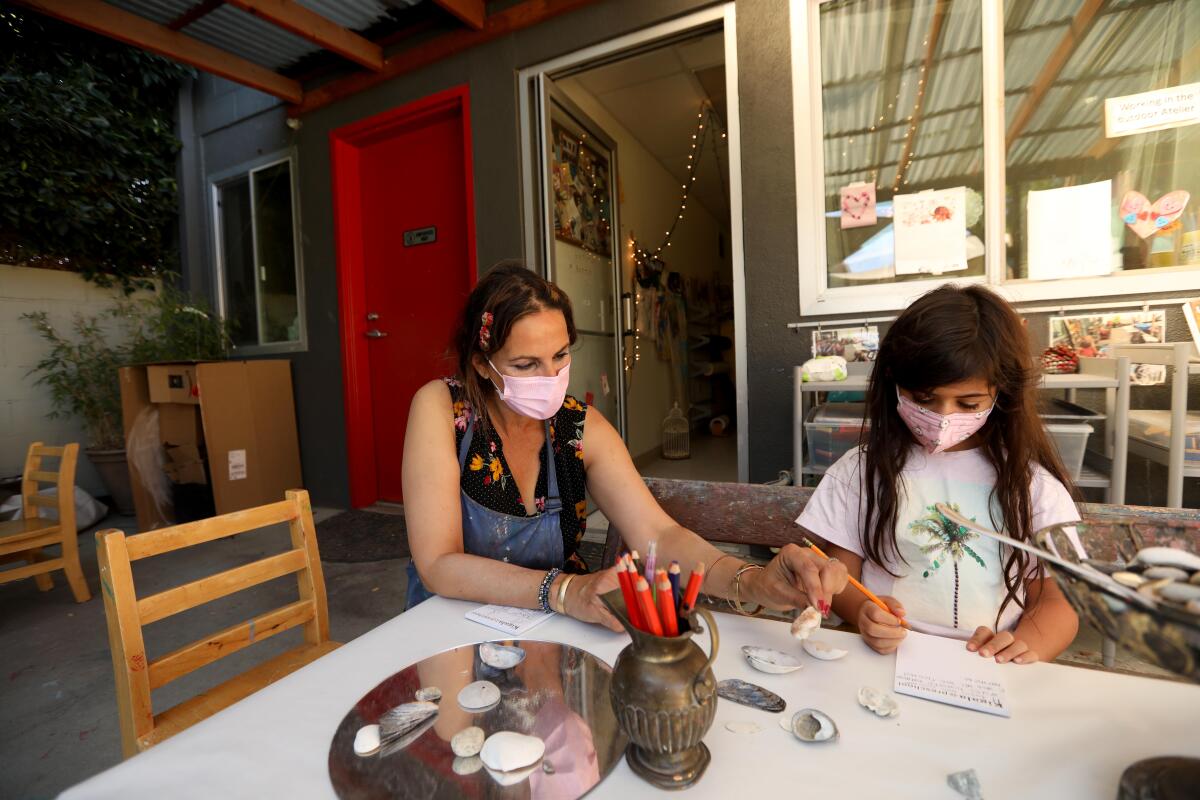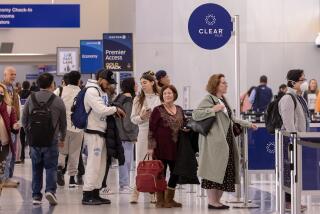Is it too risky for kids to go maskless at school and day care? What experts say

With mask mandates easing, some parents and schools will have much to think about in the coming weeks.
After Friday at 11:59 p.m., California will lift its indoor K-12 and child care mask mandate, and it’ll be up to school and child care operators to decide for themselves their own masking policy.
Health officials are strongly recommending masks still be worn in indoor public settings, but school operators will have their own power to retain a mask order or to make wearing them optional.
Here is what experts are saying about the risks and what parents need to consider.
Why masks still make sense for young children
Some parents have been eager for masks to become optional, and there are instances in which that can make sense.
It can be prudent to retain mask-wearing policies in situations where kids are too young to be vaccinated, Dr. Yvonne Maldonado, chief of infectious diseases at Stanford University School of Medicine’s pediatrics department, said in an interview.
“Masks, distancing work when you can’t be vaccinated, or when … you’re immunocompromised,” Maldonado said. Because children under 5 aren’t eligible to be vaccinated, day care centers with those younger kids “still need to use masks.”
Maldonado, who chairs the American Academy of Pediatrics Committee on Infectious Diseases, said people who say masks and distancing don’t work are wrong.
“They absolutely work. We’ve seen so much data now that they work,” Maldonado said.
In an article she wrote for healthychildren.org, a website published by the American Academy of Pediatrics, Maldonado wrote that “for some children — including those too young to be immunized and many with special healthcare needs — masking is still an important layer of protection.”
Dr. Robert Wachter, chair of UC San Francisco’s Department of Medicine, said because children age 2 to 4 are ineligible for vaccines, it would be safer for them to wear a mask until shots are available for them.
Ideally, he would expect that the day care workers would be masked and vaccinated.
But if he had a 1-year-old in a child care center, and the facility chose to go mask-optional? “I probably would just accept that there is a tiny risk of doing that, that the benefits of having the kid in day care outweigh that risk,” Wachter said. “It’s obviously not a zero-risk proposition. But the risk is, I think, quite low. And I would probably accept it.”
Vaccination demographics
People making decisions on school masking policies may want to consider what percentage of their schoolchildren are vaccinated.
Vaccination rates are highly variable, depending on age range, geography, income, and race and ethnicity. Nationwide, among children age 5 to 11, just 26% are fully vaccinated, but among ages 12 to 17, 58% are fully vaccinated. In California, about 31% of children in the younger age group are fully vaccinated, while 65% of adolescents and teens are.
Another factor to consider is the coronavirus case rate in the relevant school community. “There’s all kinds of pockets where the transmission rates are still going to be pretty worrisome,” Maldonado said. “Some school districts may still decide, you know, ‘We’re still in a high transmission neighborhood. Let’s just keep using masks for now,’” a decision she thinks is reasonable.
“It’s all about transmission,” Maldonado said. “If you still live in an area where your transmission rate is high — even if your county rate is low, but your neighborhood or your school district is high,” there’s a higher risk in unmasking in those settings.
Maldonado suggests that parents who are concerned ask why their schools are making their decisions. It can be a reasonable decision to not have schoolchildren be masked, she said, if the school district thinks the transmission risk is low. If a parent feels safe with the school’s assumption, “then I would go with not masking — as long as my kids are vaccinated, and I feel like I’ve done everything I can to keep my kids safe.”
Another factor that would give a parent more assuredness that it’s relatively safe to unmask is whether schools have good ventilation.
A trend of seeing more kids coming to school infected — or if cases aren’t dropping — might be a signal to retain a mask-wearing policy.
Maldonado said she worked with the L.A. Unified School District for more than a year to help them with its mask and testing policy. “And it’s a big, big district with a lot of uneven distribution of risks and vaccination rates and transmission rates,” Maldonado said.
There are situations in which it may make sense for children to still wear masks even if they’re not required to, such as children who are immunocompromised or who have family members at home with weakened immune systems. Children “should be allowed to wear masks if they feel like they need to, and we’re asking people to show grace and respect to those other people who want to be masked,” Maldonado said.
Florida Gov. Ron DeSantis attracted attention last week when he encouraged high school students at a news conference to take off their masks, telling them: “Please take them off. Honestly, it’s not doing anything. We’ve got to stop with this COVID theater.”
Challenges for child care centers
Child care centers for younger kids are in an especially tricky position, especially if they decide to make masking optional for workers and children. Children under 2 should not wear masks because of the risk of suffocation.
“Child care is difficult because children under 2 don’t wear masks and never have. So the protection for those children has been to try to surround them with both people who are fully vaccinated and boosted, and, of course … adults wearing their masks and older children wearing their masks,” L.A. County Public Health Director Barbara Ferrer said in an interview Friday.
“That’s especially when you have a lot of transmission, because when there’s a lot of transmission, there’s just a lot more chances that people — even in small settings — could in fact, be asymptomatic and still be infected.”
Ferrer said there’s still enough transmission in L.A. County that “parents should think about their child and their child’s particular circumstance and their home circumstance, and then work with a child care provider about what makes sense for that child.”
Younger children aren’t just vulnerable because they’re not yet eligible for vaccinations; some have “underlying conditions that put them at much higher risk, or they live with people who are very vulnerable,” Ferrer said. “It’s still reasonable to talk with your child care provider about your unique circumstance, particularly for children under 2, that can’t mask up.”
Masks still provide protection
Whether or not schools make mask-wearing optional, it’s worth noting that higher-grade masks, such as KF94 and KN95 masks, offer wearers additional protections from infection, Ferrer said, adding that her grandchildren are comfortable in KF94 masks.
“It’s good protection. So even if the folks around them aren’t going to be masked, they’re wearing a higher-grade mask, [and] they’ll have some additional protections,” Ferrer said.
A study published by the U.S. Centers for Disease Control and Prevention on Tuesday found that, in a study of Arkansas schools between August and October, districts with universal mask requirements had a 23% lower incidence of coronavirus cases compared to districts with no mask policy.
The study also looked at 26 districts that switched from no mask policy to some kind of mask policy. In those districts, a week after the mask policy was enacted, the coronavirus incidence among students and staff decreased significantly.
“Universal mask use, in coordination with other prevention strategies such as vaccination of students and staff members in K–12 schools, remains an important tool for preventing [coronavirus] transmission,” the report said.
Schools that do decide to make masking optional should make sure they pay greater attention to other infection control practices, such as encouraging handwashing frequently, especially among younger children, Ferrer said. Distancing and moving some activities outdoors can further reduce risk, Ferrer said.
It’s also true that risk is now far less than it was weeks ago in schools. According to county data, 14% of routine coronavirus tests at schools were coming back positive in early January, a record high this academic year; but for the last week of February, that rate had fallen to 0.44%. That’s higher than it was in mid-October, when it was 0.16%, but it’s still quite low.
“That means there’s a lot less risk,” Ferrer said, while acknowledging that some parents and children will still be concerned about the risk of infection.
Ferrer sympathized with parents who might feel uneasy about child care centers who choose to go mask-optional with their employees even while caring for children under 2, who can’t wear masks nor be vaccinated. “We’re strongly recommending at day cares that employees keep their masks on,” in part because “they are going to be taking care of children, many of whom cannot mask.”
Dr. Robert Kim-Farley, a UCLA epidemiologist and infectious diseases expert, said if a child younger than 2 is going into a mask-optional day care center, if there’s not older people in their household, or someone who is immunocompromised, case rates locally are now low enough that sending children into such a setting is “relatively safer than it would have been before.”
More to Read
Sign up for Essential California
The most important California stories and recommendations in your inbox every morning.
You may occasionally receive promotional content from the Los Angeles Times.












